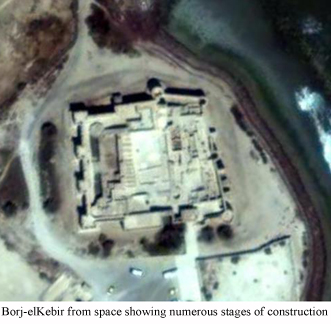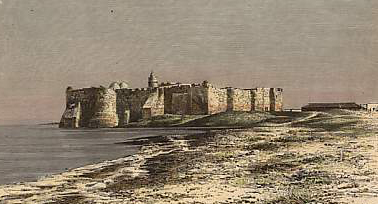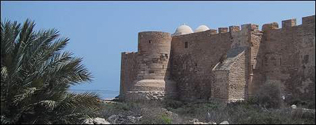In part, the war had begun over control of the trade and tribute from the North African states in the Maghreb. Initially the Crown of Aragon could not expend the resources to reclaim its influence in the region, but the situation had changed by the summer of 1284 following the Angevin defeat at Naples.
While Prince James was consolidating the gains in southern Italy,
Roger of Lauria
sailed south and attacked the island of Gerba off
 the Tunisia coast. Following the attack, Roger built the castle
called Bordj el-Kebir on the island, which he would use on his return to region
in 1286. The castle would be modified by the Arabs, Turks and
especially the Spanish in the 16th century.
the Tunisia coast. Following the attack, Roger built the castle
called Bordj el-Kebir on the island, which he would use on his return to region
in 1286. The castle would be modified by the Arabs, Turks and
especially the Spanish in the 16th century.
Roger went on to raid the island of Kerkena, but did not try to hold it at this time. In a series of raids Roger captured approximately 6,000 Muslims, as well as the Prince of Gewara, Margam Ibn Sabir. Though his actions are portrayed in the chronicles as simple raiding, the fact that Roger built a castle and garrisoned it suggests a plan to secure Gerba as an outpost in the Maghreb. Roger would later receive the island as a fief from the crown.
The Sicilian chroniclers and authors tend to portray the expedition to Gerba as simply being driven by greed on the part of Roger and the Aragonese nobles. However, while the raids did prove highly profitable in the form of ransoms and slaves, the motivation behind them was not greed but a need to finance the fleet and to control this strategic location. As the fleet accounts show, all of the profits were put into the fleet coffers.

In August 1286 Roger of Lauria launched a raid against the island of Kerkena. Unlike the raid in 1284 during which Kerkena was raided but not occupied, this time the Aragonese decided to retain control of this important island. As a result of the raid, a total of 1,254 "sarracens" of "both sexes" were captured. They were then transported to Sicily and sold at Trapani and Palermo in September and October. However, not all of the Moslems captured in the raided were sold into slavery, for an unknown number of them paid for their freedom. After receiving the ransom for these individuals, they were sent in October in two galleys to the city of Gabes where they were released. The same galleys were to also pick up the ransom for Margam ibn Sebir.

On July 30, 1287 Alfonso III signed a treaty with the Emir of Tunis reinstating tribute to both the Crown of Aragon and Sicily, and establishing commercial ties between the kingdoms. The treaty itself was not long enforced and in 1288 Roger raided the Maghreb and forced the city of Tolmetta to pay tribute to avoid being sacked.
By 1289 Alfonso III was looking for a diplomatic settlement to reestablish the tribute from Tunisia. By a treaty specified in the fleet account for 1289-1290, Gerba and the island of Kerkena paid tribute for three years covering January 1, 1290 to December 31, 1292. The treaty for tribute from Gerba and Kerkena was authorized by Alfonso III, but the tribute was collected by the office of the admiral, and went straight into the fleet coffers.
In 1290 Alfonso III tried to improve his position in North Africa by reinstalling the former ruler of Tripoli with the help of Roger and the fleet. The fleet sailed in July 1290 for Tripoli but after a short siege the parties began to fall out and the project was abandoned. Roger of Lauria went on to raid the city of Tolmetta before returning to Sicily. Because of treaties with the other states in the Maghreb, raiding the region was no longer an option and 1290 would be the last year the Catalan-Aragonese fleet would operate there for the duration of the conflict.
To learn more about the operations of the fleet in North Africa and how they influenced the War of the Sicilian Vespers see: Sea Power in the Medieval Mediterranean: The Catalan-Aragonese Fleet in the War of the Sicilian Vespers.


